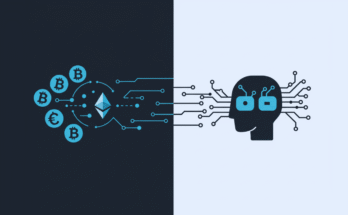Decentralized Finance, or DeFi, has transformed how people interact with financial systems by leveraging blockchain technology to offer permissionless, intermediary-free services. Unlike traditional finance, which relies on banks and brokers, DeFi operates on decentralized protocols, enabling users to lend, borrow, stake, and earn without centralized control. This beginner-friendly guide explains how DeFi works, focusing on lending, staking, and earning opportunities, along with key concepts, benefits, and risks in 2025.

What Is DeFi?
DeFi refers to a set of financial applications built on blockchain networks, primarily Ethereum, that replicate or innovate on traditional financial services. These applications use smart contracts, self-executing code on the blockchain to automate processes like lending, trading, or yield farming. DeFi’s core principles include:
- Decentralization: No single entity controls the system; protocols are governed by code or community consensus.
- Transparency: Transactions and smart contract code are publicly verifiable on the blockchain.
- Accessibility: Anyone with an internet connection and a crypto wallet can participate, no KYC required. In 2025, DeFi’s total value locked (TVL) exceeds $150 billion, reflecting its growing adoption for lending, staking, and passive income generation.
How DeFi Works? Core Components
→ DeFi relies on several building blocks:
- Blockchains: Ethereum dominates DeFi, but chains like Solana, Binance Smart Chain, and Polygon offer faster, cheaper alternatives.
- Smart Contracts: These automate financial agreements, executing actions (e.g., loan disbursal) when conditions are met.
- Decentralized Applications (DApps): User interfaces like Aave or Uniswap allow interaction with DeFi protocols.
- Crypto Wallets: Non-custodial wallets like MetaMask or Trust Wallet connect users to DeFi platforms, storing private keys securely.
- Stablecoins: Assets like USDC or DAI, pegged to fiat currencies, reduce volatility in DeFi transactions.
What Is DeFi Anyway?
DeFi refers to financial services built on blockchain technology, typically Ethereum. Unlike traditional banks or financial institutions, DeFi platforms operate without intermediaries. Instead, they rely on smart contracts self-executing code that automates transactions when certain conditions are met.
Think of it as a peer-to-peer financial system where you can save, borrow, lend, and earn. All without needing to trust a bank or middleman. Cool, right? Now let’s dive into the core components: lending, staking, and earning.
[Lending] Be Your Own Bank
Lending in the DeFi world is pretty straightforward. Instead of depositing your money into a bank and letting them decide how to use it, you can lend your crypto assets directly to other users via DeFi platforms.
→ Here’s how it works:
- Deposit Your Assets: You lock your cryptocurrency (like Ethereum or stablecoins) into a lending protocol such as Aave, Compound, or MakerDAO.
- Earn Interest: Other users borrow your assets, and in return, you earn interest. The interest rates are often more competitive than traditional banks because there’s no middleman taking a cut.
- Smart Contracts Ensure Security: The lending process is governed by smart contracts, which automate everything and ensure that borrowers provide collateral to secure the loan.
Lending is a great way to put your idle crypto to work and earn passive income. Just remember that the crypto market can be volatile, so always do your research before diving in.
[Staking] Earn Rewards While Strengthening the Network
Staking is another popular way to earn in the DeFi space. It involves locking up your cryptocurrency to support the operations of a blockchain network—typically one that uses Proof of Stake (PoS) instead of Proof of Work (PoW).
→ Here’s the breakdown:
- Lock Your Crypto: You “stake” your tokens by depositing them into a staking pool on platforms like Ethereum 2.0, Polkadot, or Solana.
- Verify Transactions: By staking your assets, you help validate transactions and secure the network. Think of it as being part of the blockchain’s security team.
- Earn Rewards: In return for your support, you receive rewards in the form of additional tokens or a percentage of transaction fees.
Staking is not only profitable but also eco-friendly. It uses far less energy than mining on PoW blockchains like Bitcoin. Plus, it’s a win-win: you earn rewards while contributing to the stability and security of the network.
[Earning] Maximizing Your Crypto Potential
→ Earning in DeFi goes beyond lending and staking. There are plenty of creative ways to grow your crypto portfolio within this ecosystem. Here are a few popular earning strategies:
Yield Farming
Yield farming is like lending on steroids. You deposit your crypto into liquidity pools on platforms like Uniswap or SushiSwap. These pools facilitate trading and allow users to swap tokens seamlessly. In return for providing liquidity, you earn rewards in the form of fees or governance tokens. Yield farming can be highly lucrative but also risky due to price fluctuations and potential smart contract vulnerabilities. Always tread carefully!
Liquidity Mining
Liquidity mining is similar to yield farming but focuses on rewarding users with native tokens of the platform they’re supporting. For example, by contributing liquidity to a protocol like Curve Finance, you might earn CRV tokens as an incentive.
Interest Bearing Tokens
Some DeFi platforms offer interest-bearing tokens like cDAI (Compound DAI) or aUSDC (Aave USDC). When you deposit your assets into these platforms, you receive these tokens in return and they automatically accrue interest over time!
Why Is DeFi So Popular?
→ DeFi has gained traction for several reasons:
- Accessibility: Anyone with an internet connection can participate, no need for credit checks or approvals from banks.
- Transparency: All transactions are recorded on the blockchain, making them visible and auditable by anyone.
- Higher Returns: Compared to traditional savings accounts or investments, DeFi often offers better yields.
- Innovation: New financial products and opportunities are constantly emerging in the DeFi space.
Things to Keep in Mind
→ While DeFi offers exciting opportunities, it’s not without risks:
- Volatility: Cryptocurrencies are known for their price swings, which can impact your earnings or collateral value.
- Smart Contract Vulnerabilities: Bugs or hacks in smart contracts can lead to losses. Choose reputable platforms with strong security measures.
- Regulatory Uncertainty: DeFi operates in a gray area of regulation in many countries, stay informed about potential changes in laws that might affect your investments.
The Future of DeFi
In 2025, DeFi continues to evolve with layer-2 scaling solutions reducing fees, cross-chain bridges enabling interoperability, and real-world asset tokenization expanding use cases. Institutional adoption is growing, with banks exploring DeFi for settlements. However, regulatory clarity and enhanced security will be critical for mainstream adoption. DeFi’s potential to democratize finance remains unmatched, offering opportunities for anyone to lend, stake, and earn in a decentralized world.
Conclusion
DeFi redefines finance by empowering users to lend, stake, and earn through transparent, decentralized protocols. Lending offers passive income, staking supports networks and liquidity, and yield farming maximizes returns for savvy users. While DeFi’s benefits accessibility, control, and innovation are compelling, risks like smart contract bugs and volatility require caution. By starting small, researching thoroughly, and using trusted platforms, you can explore DeFi’s potential safely and tap into the future of finance.



